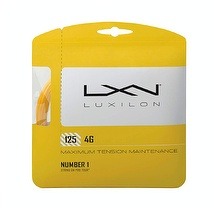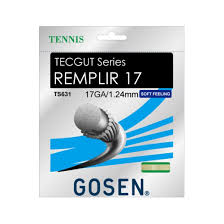Can you be like Roger?
Well in all fairness, not likely. There is a lot of misconception when it comes to what racquet, string & tension recreational players choose and I’d like to clear that up a bit on a few fronts; the racquet, string & tension. First off, as mentioned, no, forget about being like Roger or Rafa or Andy or Novak and the list goes on and on. Pro players are vastly different in so many ways that unless you yourself turn pro after decades of training, you’ll never reach the level of a true professional. Pro players hit differently, use different racquets (yes you can get their model but it’s rarely the same specs) and most importantly, the string and tension they use will not be a good match for you and your game. Consider the following:
RACQUETS-
- WEIGHT–On the men’s side you can expect that the majority of their racquets are considerably heavier than any racquet you would choose off of the shelf, even if you choose the same make and model. Why? For starters, the pace of the game is far different than any pace you’re likely to face. This is more of a physics thing than anything else so think of it this way. The more weight you have in a racquet, the easier it is to generate pace. Conversely, a heavier racquet is also going to help you negate pace from your opponents racquet. In the pro game the pace is astonishing and you really can’t appreciate it sitting in your living room watching tennis on TV. However, sitting courtside you would soon be in awe of the shear magnitude of pace being generated by the men on the ATP tour.
- BALANCE–this is going to vary from player to player but for the most part, you’ll see heavier racquets with a more “head light” or even balance than those that are “head heavy”. Think of Wilson’s numerical designations for racquets. The lower the number, as in Hyper Hammer 2.0, the more the majority of weight is distributed towards the head of the frame. If you look at the specs on these racquets you’ll also notice that they’re also very light. So, in order for a player to be able to generate any pace at all with such a light racquet, it needs to have more mass in the head, thus, a “head heavy” balance. The Hyper Hammer 2.0 weighs a mere 8.3 ounces (235 grams) strung and has a balance of 10 points “head heavy” That 2.0 designation on the frame is for Wilson’s “Swing Index” and again, this is for a lightweight, head heavy racquet so the SI for that frame is slow, short & compact. Get it? If you look at a Wilson Hammer 7.3 you get the exact opposite. That higher 7.3 designation means the racquet is going to be heavier (10.3 ounces (292 grams), with a balance of 3 points head heavy. So you have a difference of 2 full ounces (57 grams) of weight and a whopping 7 points difference on the balance. So now you should be getting the picture of how different racquets are suited for different playing styles and levels.
Racquet conclusion: Your frame is not going to weigh the same or be balanced the same as many top pros.
STRING-
-

Luxilon 4G Ah yes, give me that “new” string all the pros are playing with BUT, not so fast. It’s most likely not the string for you. That new string you often hear the TV announcers referring to is polyester and in many of the top touring pros frames that string is Luxilon. So if it works for them why won’t it work for me? For starters, a good set of Luxilon is going to cost on average, $40 – $45 per set installed. At tournaments, most pro players have their racquets re-strung before every match and some have them strung for their practice day too. If you figured an average of $45 per stringing and if you just strung 4 times a week that’s $180. IMHO, there just aren’t that many recreational players, if any at all, that are going to do that. Many polyester strings are quite stiff and they lose tension very fast, a point worth noting as to why pros re-string so often. You, on the other hand, may assume as many recreational players do, that since the string is not broken there’s no need to change it. That’s a VERY BAD idea. Strings should be changed frequently, especially polyester strings that lose tension very quickly.
- The “new” strings have little to no elongation, meaning they do not stretch at impact. For a lower level recreational player, that means you’ll have to do all the work yourself because if a string does not stretch at impact, it’s not storing
 any energy from ball contact, and that translates into no power from your strings. Now, remember above when I was talking about weight? If you’re using a very light racquet and a very stiff string you’ve just set yourself up for a painful and unenjoyable experience. Your light racquet and stiff string means you’ll have to swing so hard just to get the ball over the net and passed the service line. After weeks of this pounding you’ll be complaining about how much your arm/elbow hurts.
any energy from ball contact, and that translates into no power from your strings. Now, remember above when I was talking about weight? If you’re using a very light racquet and a very stiff string you’ve just set yourself up for a painful and unenjoyable experience. Your light racquet and stiff string means you’ll have to swing so hard just to get the ball over the net and passed the service line. After weeks of this pounding you’ll be complaining about how much your arm/elbow hurts. - Softer strings made from nylon (think synthetic gut etc) on the other hand, stretch at impact and absorb energy from the ball. When they rebound, they return that energy and add power to your shot. Now add a racquet with a reasonable weight and you have a combination that’s physically safe and will have you striking the ball like never before.
String conclusion – stick with a softer nylon string, especially the multifilament like Gosen Remplir, Wilson Sensation or Tecnifibre NRG²
TENSION-
- After years of watching players using ridiculously high tensions we’re finally starting to see players gravitating downwards. Why? Logic tells us that the more a string stretches at impact the more energy it absorbs as mentioned above. But there’s also a dynamic in a racquet called the “trampoline effect”. Basically, the lower you string, the more the string gives, creating an effect just like bouncing on a trampoline. However, there is a point of no return. You can string a racquet so loose that you simply cannot control the ball and it’s going to fly everywhere. So, the key here is to work with a trained technician to find the right string and tension for your level and style of play as well as how it performs in the racquet you’re using. We’re now seeing touring professionals using that “new” string and stringing in the mid to upper 30 pound range! You heard me right. They’re not even breaching 40 pounds and they’re doing just fine. Leander Paes, a very accomplished doubles player, was using polyester string at 61 pounds and it was suggested by a coach to lower the tension to 47. It literally caused a resurgence in his career and he’s still going strong today. As recently as 2012, Federer’s reported tension was 49 on his natural gut mains and 46.2 on his Luxilon ALU Rough cross strings. American Jack Sock is in that 35-40 pound range as well and as the word travels among the pro ranks, we’ve been seeing a lot more players dropping tension.
Tension conclusion – work with a trained racquet technician who can offer professional advice on string types and tensions that work best for your racquet/string setup and playing style. If you insist on a stiffer polyester string make sure you string it at lower tensions.

Leave a Reply
You must be logged in to post a comment.